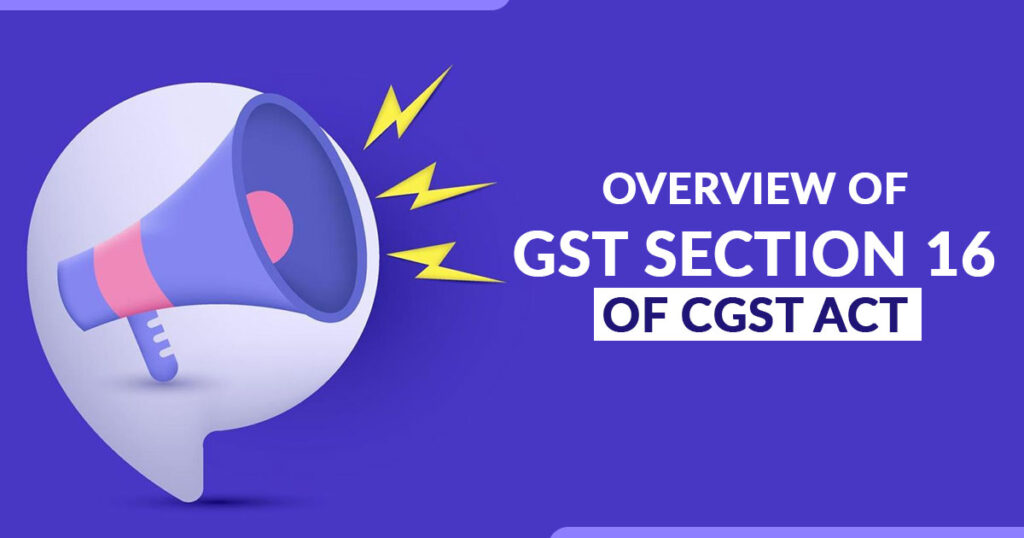Section 16 of the CGST Act: Conditions and Time Limits for Availing ITC
Input Tax Credit, or ITC, is a cornerstone of India’s Goods and Services Tax (GST) regime. For businesses, it’s a vital mechanism that significantly reduces the tax burden and prevents the cascading effect of taxes (tax on tax). However, claiming ITC isn’t automatic; it’s governed by specific rules laid out in the GST law. Section 16 of the Central Goods and Services Tax (CGST) Act, 2017, is the primary provision that outlines the eligibility criteria and prerequisites for taking this credit. Understanding these rules is absolutely critical for small business owners and even salaried individuals earning business income in India. Failing to comply can lead to denied credits, impacting cash flow and potentially resulting in penalties. This post will provide a detailed breakdown of the specific conditions and time limits for availing ITC as mandated by Section 16, helping you ensure compliance and maximize your eligible credit.
What is Input Tax Credit (ITC) under GST?
Defining ITC
In simple terms, Input Tax Credit means that when you pay GST on your business purchases (inputs like raw materials, capital goods like machinery, or input services like professional fees), you can claim that GST amount back as a credit. This credit can then be used to offset the GST you collect on your sales (output tax liability). Imagine you buy raw materials worth ₹10,000 and pay ₹1,800 as GST (assuming 18%). Later, you sell the finished product for ₹20,000 and collect ₹3,600 as GST. Instead of paying the full ₹3,600 to the government, you can use the ₹1,800 ITC you earned on purchases. You would only need to pay the balance of ₹1,800 (₹3,600 – ₹1,800) in cash.
The ‘Why’: Importance of ITC
The core purpose of ITC is to eliminate the cascading effect of taxes, which was a major issue in the pre-GST era. Cascading means tax being levied on tax at different stages of production and distribution, unfairly inflating costs. By allowing credit for taxes paid at each stage, ITC ensures that tax is effectively levied only on the value added at that stage. This makes the final price of goods and services more competitive, reduces the overall tax burden on businesses, and promotes transparency in the supply chain. Properly managing ITC availing conditions India is therefore crucial for maintaining healthy profit margins and efficient working capital management.
Section 16(1) & (2): Core Conditions for Availing ITC
Section 16 of the CGST Act sets forth the fundamental requirements that every registered person must satisfy to be eligible for Input Tax Credit. It’s crucial to understand that these are mandatory conditions, and failure to meet even one can result in the denial of ITC. The law states that a registered person is entitled to take credit of input tax charged on any supply of goods or services used or intended to be used in the course or furtherance of his business, subject to fulfilling specific section 16 CGST Act conditions. Let’s break down these essential conditions laid out primarily in Section 16(2).
Condition 1: Possession of Tax Invoice or Debit Note (Sec 16(2)(a))
The very first requirement is documentary evidence. You must possess a valid tax invoice, a debit note issued by the supplier, or any other tax-paying document prescribed under the GST Rules (like a bill of entry for imports). This document is the primary proof that a taxable supply occurred and that GST was charged. A ‘valid’ tax invoice isn’t just any bill; it must contain specific details as mandated by Rule 46 of the CGST Rules. These typically include the supplier’s and recipient’s GSTIN (Goods and Services Tax Identification Number), invoice number and date, Harmonized System of Nomenclature (HSN) code for goods or Service Accounting Code (SAC) for services, description of goods/services, quantity, taxable value, rate and amount of tax (CGST, SGST/UTGST, IGST), place of supply, and signature (physical or digital). Without a proper, compliant tax document in your possession, your claim for ITC stands on shaky ground.
Condition 2: Receipt of Goods or Services (Sec 16(2)(b))
Possessing an invoice alone is not enough; you must have actually received the goods or services (or both) for which you are claiming ITC. The credit is linked to the actual supply taking place. The law, however, provides some flexibility. For instance, in a ‘Bill to Ship to’ transaction, where goods are delivered by the supplier to a third party on the direction of the buyer (recipient), the buyer is deemed to have received the goods even if they never physically possessed them. Another important point arises when goods are received in installments or lots against a single invoice. In such cases, Section 16(2) clarifies that the registered person can claim ITC only upon the receipt of the last lot or installment. This ensures that the credit is claimed only after the entire contracted supply against that invoice is completed.
Condition 3: Tax Charged Actually Paid by Supplier (Sec 16(2)(c))
This is perhaps one of the most critical and often challenging conditions. The law requires that the tax charged by the supplier on the invoice you hold must have been actually paid to the government by that supplier. This payment can be made either through cash (Electronic Cash Ledger) or by utilizing their own ITC (Electronic Credit Ledger). How can you, as a recipient, ensure this? The GST system provides a mechanism through Form GSTR-2B. This auto-drafted statement reflects the ITC available to you based on the outward supply details (Form GSTR-1) filed by your suppliers. If an invoice from your supplier appears in your GSTR-2B, it generally indicates that the supplier has declared that liability in their return. Claiming ITC only based on invoices reflected in GSTR-2B has become standard practice and is crucial for meeting these CGST Act conditions India. If the supplier defaults on paying the tax to the government, the recipient’s ITC could be questioned or reversed later, even if the recipient fulfilled all other conditions.
Condition 4: Furnishing of Return (Sec 16(2)(d))
The entitlement to ITC is actualized only when the recipient claims it in their GST return. Section 16(2)(d) mandates that the registered person (the recipient) must have furnished the return required under Section 39 of the CGST Act. This return is typically Form GSTR-3B, which is a summary return filed monthly (or quarterly, for QRMP scheme taxpayers) where taxpayers declare their outward supplies, input tax credit, and pay their net tax liability. You cannot avail ITC simply by having the invoice and receiving goods; it must be formally claimed in your filed GSTR-3B for the relevant tax period. This step integrates the ITC claim into the formal compliance framework.
Additional Condition (Proviso): Payment to Supplier within 180 Days
Beyond the four main conditions in Section 16(2), a significant proviso adds another layer of compliance. If a recipient claims ITC on an invoice but fails to pay the supplier the amount towards the value of the supply along with the tax payable thereon within 180 days from the date of issue of the invoice, the ITC previously availed becomes problematic. The recipient is required to add an amount equal to the ITC availed back to their output tax liability for the month immediately following the expiry of the 180-day period. They will also be liable to pay interest on this amount from the date of availing the credit till the date when the amount is added back to the output tax liability. However, the good news is that if the recipient subsequently makes the payment to the supplier, they are entitled to re-avail the credit without any time limit (other than the overall limit discussed next). This rule encourages timely payment to suppliers and ensures the integrity of the credit chain.
Section 16(4): Strict Time Limits for Availing ITC
While meeting the eligibility conditions under Section 16(2) is necessary, it’s not sufficient on its own. Section 16(4) introduces a crucial deadline – the time limits for availing ITC. This provision mandates that Input Tax Credit for invoices or debit notes pertaining to a specific financial year must be claimed within a defined timeframe. Missing this deadline means the credit is lost forever, directly impacting your business’s bottom line. Understanding and adhering to these timelines is non-negotiable for effective GST management.
The Specific Deadline
As per the current provision of Section 16(4) (amended by the Finance Act, 2022, effective from October 1, 2022), a registered person cannot claim Input Tax Credit in respect of any invoice or debit note for the supply of goods or services (or both) pertaining to a financial year after the 30th day of November following the end of that financial year, OR the date of furnishing of the relevant annual return (Form GSTR-9/9C) for that financial year, whichever is earlier. It is absolutely critical to note the ‘whichever is earlier’ clause. You cannot wait until November 30th if you file your annual return before that date. The time limits for availing ITC are strict and unforgiving. These ITC conditions and time limits must be tracked meticulously.
Example Scenario
Let’s illustrate this with an example. Suppose your business received goods and corresponding invoices during the Financial Year 2023-24 (i.e., from April 1, 2023, to March 31, 2024). According to Section 16(4):
- The deadline based on the date is November 30, 2024.
- The deadline based on the annual return filing depends on when you file your GSTR-9 for FY 2023-24. Let’s say you file it on October 25, 2024.
In this scenario, the earlier date is October 25, 2024. Therefore, the last date for you to claim any remaining ITC pertaining to invoices or debit notes of FY 2023-24 would be October 25, 2024 (i.e., in the GSTR-3B filed for the period covering this date, typically the October 2024 return filed in November 2024, but the entitlement cut-off is linked to the annual return filing date if earlier than Nov 30th). If you hadn’t filed your annual return by November 30, 2024, then November 30, 2024, would be the absolute final deadline.
Consequence of Missing the Deadline
The consequence is straightforward and harsh: permanent loss of credit. If you fail to claim the ITC related to a financial year within the timeframe specified by Section 16(4), you forfeit that credit entirely. There is no provision to claim it in subsequent returns or apply for condonation of delay for claiming ITC under Section 16(4). This makes timely accounting, reconciliation, and return filing absolutely paramount. Businesses must ensure their systems are robust enough to capture all eligible credits and claim them well before the deadline.
Key Takeaways and Compliance Checklist
Navigating the rules of Section 16 requires careful attention to detail. To help you stay compliant, here’s a summary checklist of the core conditions and the crucial time limit:
- Possess Valid Document: Ensure you have a tax invoice, debit note, or other valid document compliant with GST rules (Rule 46).
- Receive Goods/Services: Confirm the actual receipt of goods or services (or deemed receipt in ‘Bill to Ship to’ cases). Remember the ‘last lot’ rule for installment supplies.
- Check Supplier Tax Payment (GSTR-2B): Regularly check your Form GSTR-2B on the GST Portal. ITC is generally allowed only for invoices appearing here, indicating the supplier has filed their GSTR-1 and declared the liability. This is a key check for
CGST Act conditions India. - File Your Return (GSTR-3B): You must claim the eligible ITC by correctly reporting it in your filed Form GSTR-3B for the relevant tax period.
- Pay Supplier Within 180 Days: Ensure payment for the invoice value (including tax) is made to the supplier within 180 days from the invoice date to avoid ITC reversal plus interest. Re-claim is possible upon payment.
- Meet the Deadline (Sec 16(4)): Claim ITC for a financial year by November 30th of the following financial year OR the date of filing the Annual Return for that year, whichever is earlier. Missing this deadline means losing the credit permanently.
Actionable Tip: Implement a system for regular (preferably monthly) reconciliation of your purchase records with your GSTR-2B. Identify discrepancies immediately. Proactively follow up with suppliers whose invoices are missing in GSTR-2B or contain errors. Prompt action is key to ensuring you don’t miss out on eligible ITC due to supplier non-compliance or lapse the time limits for availing ITC.
Conclusion: Ensuring Compliance with ITC Conditions and Time Limits
Input Tax Credit is a significant benefit under the GST regime, but it comes with strict responsibilities. Adhering to the provisions of Section 16 of the CGST Act is not just about compliance; it’s fundamental to managing your business’s finances effectively, optimizing working capital, and ensuring accurate tax payments. Every GST-registered business must have a clear understanding and robust processes to implement the conditions and time limits for availing ITC. From ensuring you have the right documents and confirming receipt of supplies to verifying supplier compliance via GSTR-2B, making timely payments, and strictly adhering to the claiming deadlines – each step is crucial.
Navigating the complexities of section 16 CGST Act conditions and keeping track of deadlines can be challenging, especially for small businesses. If you need assistance with GST return filing, ITC reconciliation, understanding specific scenarios, or ensuring overall GST compliance, don’t hesitate to seek expert help. TaxRobo offers comprehensive GST services tailored for businesses like yours.
Need help managing your ITC and GST compliance? Contact TaxRobo today for expert guidance and ensure you never miss out on eligible credits.
Frequently Asked Questions (FAQs)
Q1: Can I claim ITC if the invoice from my supplier is not showing in my GSTR-2B?
Answer: Generally, claiming ITC for invoices not reflected in your Form GSTR-2B is highly risky and likely to be disallowed by the tax authorities. GSTR-2B serves as the primary basis for determining ITC eligibility, indicating that the supplier has reported the supply in their GSTR-1. While the law’s core conditions don’t explicitly make GSTR-2B mandatory *yet*, Rule 36(4) (though currently amended) and departmental practice heavily rely on it. It’s best practice to contact your supplier immediately and ask them to file their GSTR-1 correctly so the invoice appears in your GSTR-2B. Claiming ITC without this visibility could lead to notices and demand for reversal with interest.
Q2: What happens if I miss the November 30th deadline to claim ITC for the previous financial year?
Answer: If you fail to claim ITC for invoices/debit notes pertaining to a financial year by the deadline specified in Section 16(4) (i.e., November 30th of the next financial year or the date of filing the annual return, whichever is earlier), that ITC is permanently lost. The strict time limits for availing ITC mean you cannot claim this lapsed credit in any future tax period. There is no provision under the GST law to extend this deadline or allow belated claims under Section 16(4).
Q3: I am registered under the GST Composition Scheme. Do these ITC rules apply to me?
Answer: No. Businesses registered under the GST Composition Scheme operate under a simplified tax regime. They pay tax at a fixed, lower rate on their turnover and are not eligible to claim Input Tax Credit on their purchases. Consequently, the conditions and time limits discussed under Section 16 do not apply to Composition Scheme taxpayers. These rules are applicable only to taxpayers registered under the regular GST scheme who are eligible to take ITC.
Q4: Is ITC available on capital goods purchase?
Answer: Yes, Input Tax Credit is generally available on capital goods (like machinery, equipment, furniture, computers) that are used or intended to be used in the course or furtherance of business. The same conditions under Section 16(1) and 16(2) (possession of invoice, receipt, tax paid by supplier, return filing) and the time limits under Section 16(4) apply. However, there’s an important condition: You cannot claim ITC on the GST component of capital goods if you have claimed depreciation on that tax component under the Income Tax Act, 1961. Additionally, certain capital goods might fall under the list of blocked credits specified in Section 17(5) (e.g., motor vehicles for certain uses), making ITC unavailable.
Q5: Where can I officially check these rules and my ITC eligibility?
Answer: The definitive source for GST law is the Central Goods and Services Tax (CGST) Act, 2017, and the associated CGST Rules, 2017, along with any amendments, notifications, and circulars issued thereafter. You can find these on the official website of the Central Board of Indirect Taxes and Customs (CBIC). For checking your specific ITC eligibility based on supplier filings, you should log in to the Official GST Portal. Your auto-drafted ITC statement, Form GSTR-2B, is available there, providing details of ITC available for a particular tax period.



